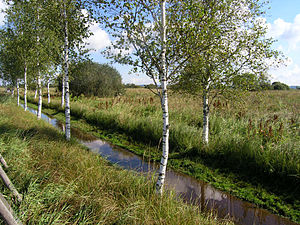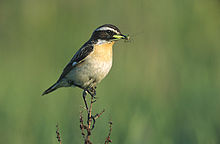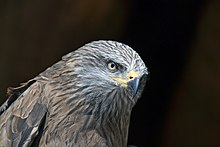Federseeried (bird sanctuary)
|
Bird sanctuary (SPA)
"Federseeried" |
||
| location | District of Biberach in Baden-Wuerttemberg , Germany | |
| WDPA ID | 555537928 | |
| Natura 2000 ID | DE-7923-401 | |
| Bird sanctuary | 29.298 km² | |
| Geographical location | 48 ° 4 ' N , 9 ° 38' E | |
|
|
||
| Sea level | from 578.5 m to 584 m ( ø 580 m) | |
| Setup date | November 20, 2007 | |
| administration | Regional Council Tübingen | |
The area Federseeried is a 2007 equipped with Regulation of 5 February 2010 by the Ministry of Food and Rural Areas specified European bird sanctuary (reserve identifier DE-7923-401) in the district of Biberach in Baden-Württemberg in Germany .
description
The Federseeried area is described as a "reed landscape with eutrophic shallow lake, wide reed belt, large and small sedge, marsh grass meadows, agriculturally used wet meadows, wet meadows, swamp forests, secondary swamp forests, covered peat cuttings and denied raised bogs ".
Habitat classes
| Mixed forest | 5% | |||
| Inland waters, standing and flowing | 36% | |||
| Bogs, swamps, vegetation on the banks | 52% | |||
| Meliorated grassland | 7% | |||
location
The approximately 3,000 hectare (ha) bird sanctuary in Federseeried is divided between the two cities of Bad Buchau (989.07 hectares) and Bad Schussenried (541.01 hectares) as well as eight communities in Alleshausen (388.22 hectares) and Betzenweiler (88.67 hectares) ), Kanzach (94.97 ha), Moosburg (56.40 ha), Oggelshausen (470.31 ha), Seekirch (156.83 ha), Tiefenbach (122.96 ha) and Uttenweiler (21.41 ha) in Biberach district .
Protection purpose
The area-related conservation objectives are described differently depending on the species :
Common Common Snipe ( Gallinago gallinago )
Preservation of wet meadow complexes, in particular with litter meadows or extensively used wet meadows, near-natural moors, the silting areas of stagnant waters with light reeds or sedge beds, habitats without sources of danger such as overhead lines, preservation of temporarily flooded depressions, wet arable fields and ditches that constantly carry water. , Reed and perennial borders as well as maintenance of undisturbed or at least undisturbed breeding sites during the breeding season from February 15th to August 15th.
Bluethroat ( Luscinia svecica )
Preservation of silting zones, reeds and moist, loose willow bushes, flowing waters and their floodplains, preservation of richly structured ditch edges, dams and embankments, of early stages of succession, of secondary habitats such as abandoned peat cuttings with the aforementioned habitats, preservation of the food supply, especially with insects and their larvae as well Preservation of undisturbed or at least undisturbed breeding sites during the breeding season (March 15 to August 15).
Whinchat ( Saxicola rubetra )
Preservation of largely late-mowed extensively managed grassland complexes, large sedge areas, moors and heaths, fringing strips such as road and field borders as well as edge strips, old grass strips, fallow and wood-free embankments, isolated bushes, tall perennials, piles of stones and others as hunting, sitting and Singwarten suitable structures, secondary habitats such as abandoned mining sites with the aforementioned habitats, the food supply as well as undisturbed or at least undisturbed breeding sites during the breeding season from May 1 to August 31.
Common tern ( Sterna hirundo )
Preservation of near-natural lakes with gravel and gravel banks or alluvial sand islands, preservation of a water quality that guarantees good visibility for prey, preservation of nesting opportunities, of secondary habitats such as abandoned mining sites with open gravel islands, preservation of the food supply with small fish species and juvenile fish as well as preservation of undisturbed or at least low-disturbance Breeding sites during the breeding season from April 1st to September 30th.
Gray woodpecker ( Picus canus )
Preservation of richly structured light deciduous and mixed deciduous forests with open areas for feeding, of alluvial forests, of extensively cultivated orchards, preservation of poor grasslands, poor hay meadows or cattle pastures, preservation of edge strips, rain areas, embankments and lined, stepped forest edges, of old wood islands and old wood islands , especially of standing dead wood, preservation of trees with large caves and the food supply.
Curlew ( Numenius arquata )
Preservation of spacious, open and uncut cultivated landscapes without visible barriers, of grassland, in particular of extensively used meadows, of temporally differentiated uses in low-lying meadow complexes, of wet soil conditions with soft, pageable subsoil, of high groundwater levels, preservation of near-natural moors, preservation of the sedges, the Habitats without sources of danger such as overhead lines and wire fences, preservation of the food supply, especially with insects, worms and smaller vertebrates, as well as maintenance of undisturbed or at least undisturbed breeding sites during the breeding season (February 1 to August 31).
Hen harrier ( Circus cyaneus )
Preservation of extensively used wet meadows and pastures, of reed areas, of tall herbaceous meadows and fallow land in the grassland areas, preservation of habitats without sources of danger such as non-bird-safe overhead lines and wind turbines, preservation of the food supply, especially with small mammals and small birds living on the ground, as well as maintenance of undisturbed or at least low-disturbance sites during breeding the breeding season from April 1st to August 31st.
Common teal ( anas crecca )
Preservation of the eutrophic vegetation-rich shallow water lakes, small bodies of water and wet meadow ditches carrying water, the slow-flowing waters with shallow water zones, the vegetation-rich moor lakes, the silted areas with reed beds, sedge beds, water-bearing wood, silt areas and shallow water zones, preservation of secondary habitats such as abandoned mining sites as well as conservation with the aforementioned habitats or at least poorly disturbed breeding or moulting sites during the breeding and rearing season (March 15 to August 31) and the moult (July 1 to September 30).
Northern gray shrike ( Lanius excubitor )
Preservation of extensive, extensively managed orchards with numerous bushes, of hedge areas with the small structures there such as stone hedges, small fallow land, swampy depressions, individual bushes and trees, unpaved field paths, preservation of grazed juniper heaths with groups of bushes and trees, preservation of lean grassland, of wasteland - and fallow land as well as fringing strips, preservation of the moors with bushes and break forest islands, the springy places and swampy depressions, preservation of uncut landscapes, in particular without paved paths and roads, preservation of the food supply, especially with small mammals and large insects as well as preservation of undisturbed or at least undisturbed breeding sites during the breeding season from February 15th to July 15th.
Marsh harrier ( Circus aeruginosus )
Preservation of silting zones, reed beds and large sedge beds, wet meadow complexes, in particular with litter meadows or extensively used wet meadows, habitats without sources of danger such as non-bird-safe overhead lines and wind turbines, preservation of grass and shrub fringes, secondary habitats such as abandoned mining sites or at least the aforementioned habitats and conservation low-disturbance breeding sites during the breeding season from March 15th to September 15th.
Red kite ( Milvus milvus )
Preservation of diversely structured cultural landscapes with sparse forests, of field trees, large individual trees and rows of trees in the open landscape, of grassland, of old wood islands and old, large-crowned trees with free approach, preservation of trees with clumps, habitats without sources of danger such as non-bird-safe overhead lines and Wind turbines and the maintenance of undisturbed or at least low-disturbance breeding sites during the breeding season from March 1st to August 31st.
Reed Warbler ( Acrocephalus schoenobaenus )
Preservation of water bodies with extensive silting zones, the Großseggenriede as well as wet but not extensively flooded, loose reed beds with a pronounced herbaceous layer and individual bushes, preservation of secondary habitats such as abandoned mining sites with the aforementioned siltation zones, preservation of the food supply - especially with insects, as well as preservation of trouble-free or at least low-disruption sites the breeding season from April 1st to July 31st.
Stonechat ( Saxicola rubicola )
Preservation of heaths and moors, reeds and litter meadows, preservation of roads and fields, fringing strips, embankments, smaller field trees, unpaved field paths, marginal and old grass strips as well as fallow areas, of isolated bushes, tall perennials, cairns and other than hunting, Structures suitable for sitting and singing areas, secondary habitats such as abandoned mining sites with the aforementioned habitats, and maintenance of the food supply, in particular with insects and spiders.
Black kite ( Milvus migrans )
Preservation of diversely structured cultural landscapes, of sparse forests, in particular alluvial forests, of field trees, large individual trees and rows of trees in the open landscape, grassland, islands of old wood and old, large-crowned trees with free approach, especially near the forest edge, preservation of natural flowing and still waters, conservation of trees with clumps, of habitats without sources of danger such as non-bird-safe overhead lines and wind turbines as well as maintenance of undisturbed or at least undisturbed breeding sites during the breeding season from March 1st to August 15th.
Spotted Moorhen ( Porzana porzana )
Preservation of silting zones with low-flooded varied herbaceous vegetation such as in transition zones between reed beds and large sedge beds, in the bank area of extensive reed stands and in flooded wet meadows, the habitats without sources of danger such as overhead lines, maintenance of a flat overflow of the habitats during the entire breeding season (15 March to 15 March) August), preservation of secondary habitats such as waterlogging peat cuttings and drainage ditches with strips of reeds, sedge bulbs and a loose herbaceous layer as well as preservation of undisturbed or at least undisturbed breeding sites during the breeding season.
Corn Corn ( Crex crex )
Preservation of structurally rich and extensively used grassland, in particular with litter meadows or wet meadows, moulting and alternative places such as grass, reed and perennial borders, fallow land, individual low shrubbery and field hedges, of forms of cultivation with late mowing from August 15, of fresh up to wet soil conditions, preservation of habitats without sources of danger such as overhead lines, the food supply, especially with insects, snails and earthworms, as well as maintenance of undisturbed or at least undisturbed breeding sites during the breeding season from April 15 to August 15.
Water rail ( Rallus aquaticus )
Preservation of standing water with shallow water zones, flowing water sections and water ditches with covered bank vegetation, reeds and moors with at least small open water areas, covered silted areas with shallowly flooded reed beds, large sedge beds and bank bushes, habitats without sources of danger such as overhead lines, preservation of secondary habitats such as abandoned quarries with the aforementioned habitats as well as maintenance of undisturbed or at least low-disturbance breeding sites during the breeding season (March 15 to September 15).
White stork ( Ciconia ciconia )
Preservation of extensive, extensively used grassland with wet meadows and cattle pastures, temporally differentiated uses in grassland, of grass, reed and perennial borders, especially in connection with meadow ditches, of high groundwater levels, maintenance of fens, small bodies of water, water ditches and of temporarily flooded depressions , the habitats without sources of danger such as non-bird-safe overhead lines and unsecured chimneys, the nest sites and nesting aids as well as maintaining the food supply, especially with small mammals, amphibians, reptiles, large insects and worms.
See also
Web links
- Standard data sheet for the "Federseeried" bird sanctuary
- Profile of the SPA area Federseeried in the protected area directory of the LUBW
- Regional Council Tübingen (Ed.): Management plan for the FFH area 7923-341 "Federsee and Blinder See bei Kanzach" and the bird sanctuary 7923-401 "Federseeried" . edited by S. Hoffmeier, M. Broghammer & J. Einstein. August 7, 2018 (250 pages, baden-wuerttemberg.de [PDF]).
Individual evidence
- ↑ Ordinance of the Ministry of Food and Rural Areas establishing European bird protection areas (VSG-VO). Retrieved August 22, 2018 .
- ↑ Annex 1 of the ordinance of the Ministry of Food and Rural Areas establishing European bird protection areas (VSG-VO) of February 5, 2010. Accessed on August 22, 2018 .








